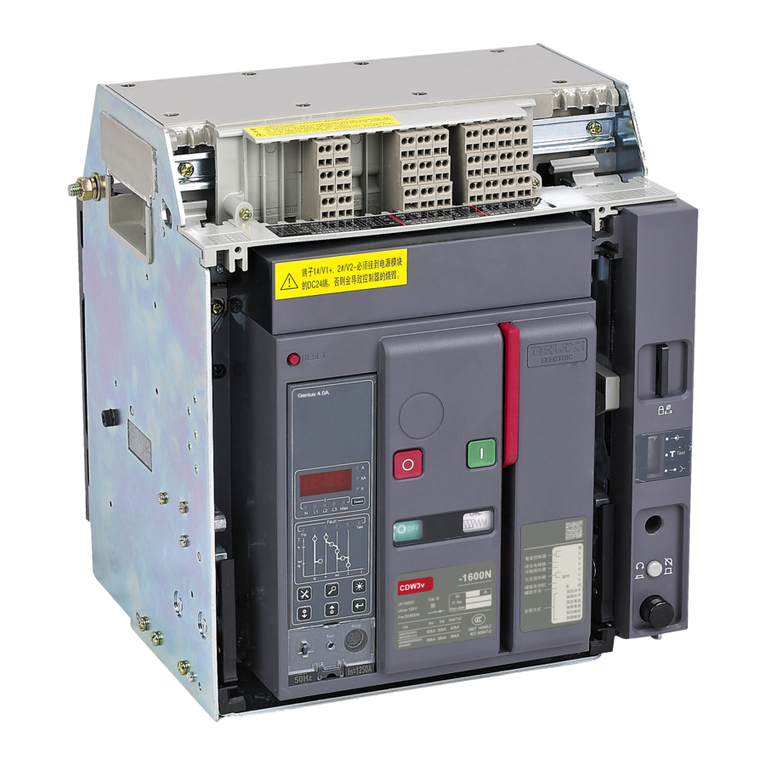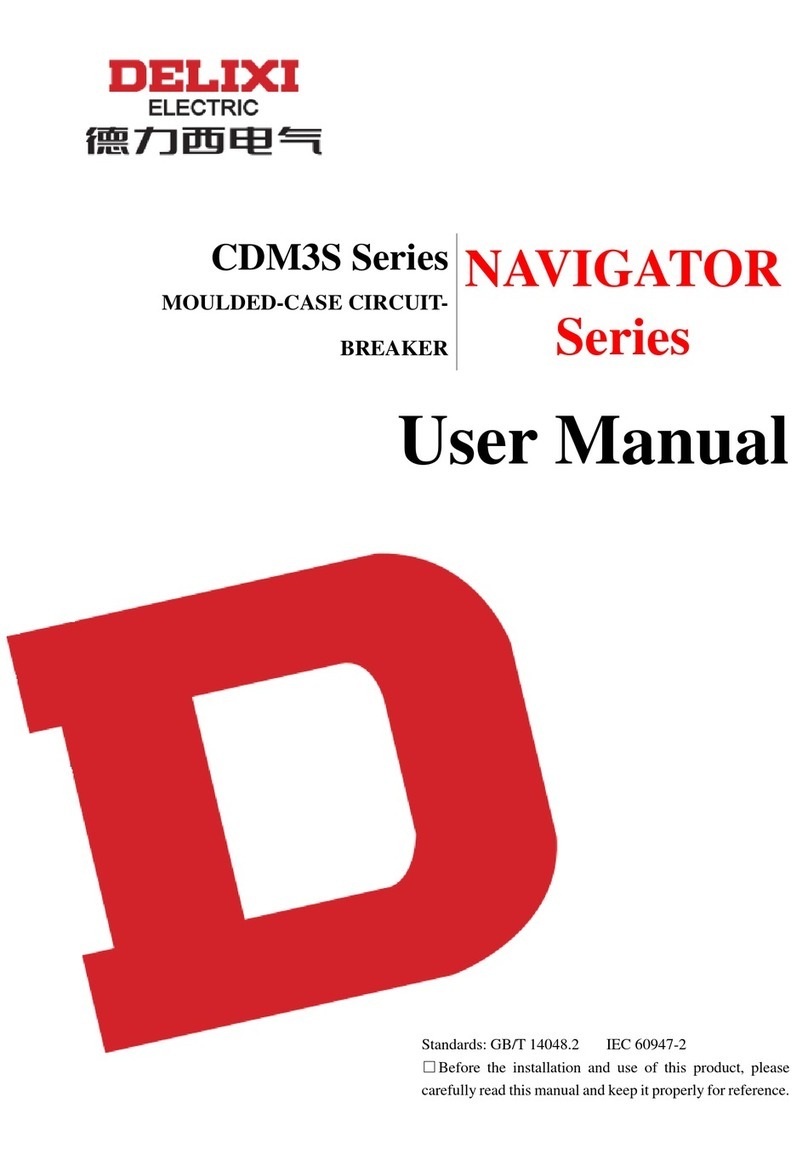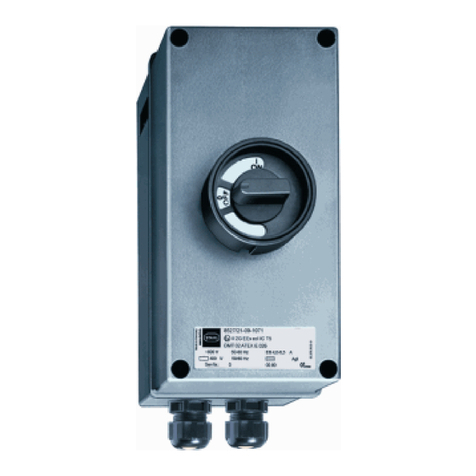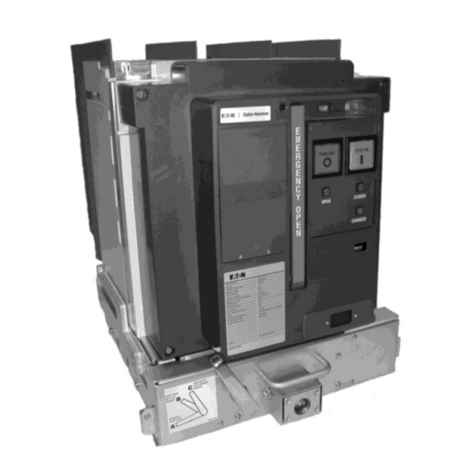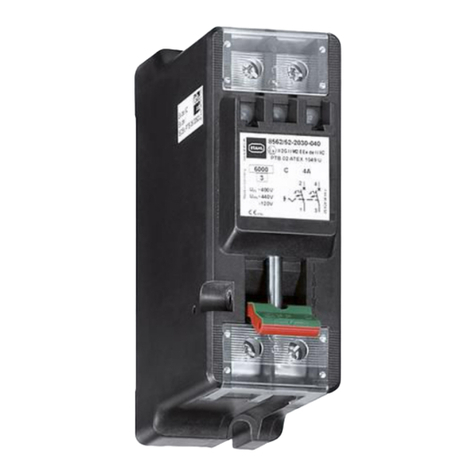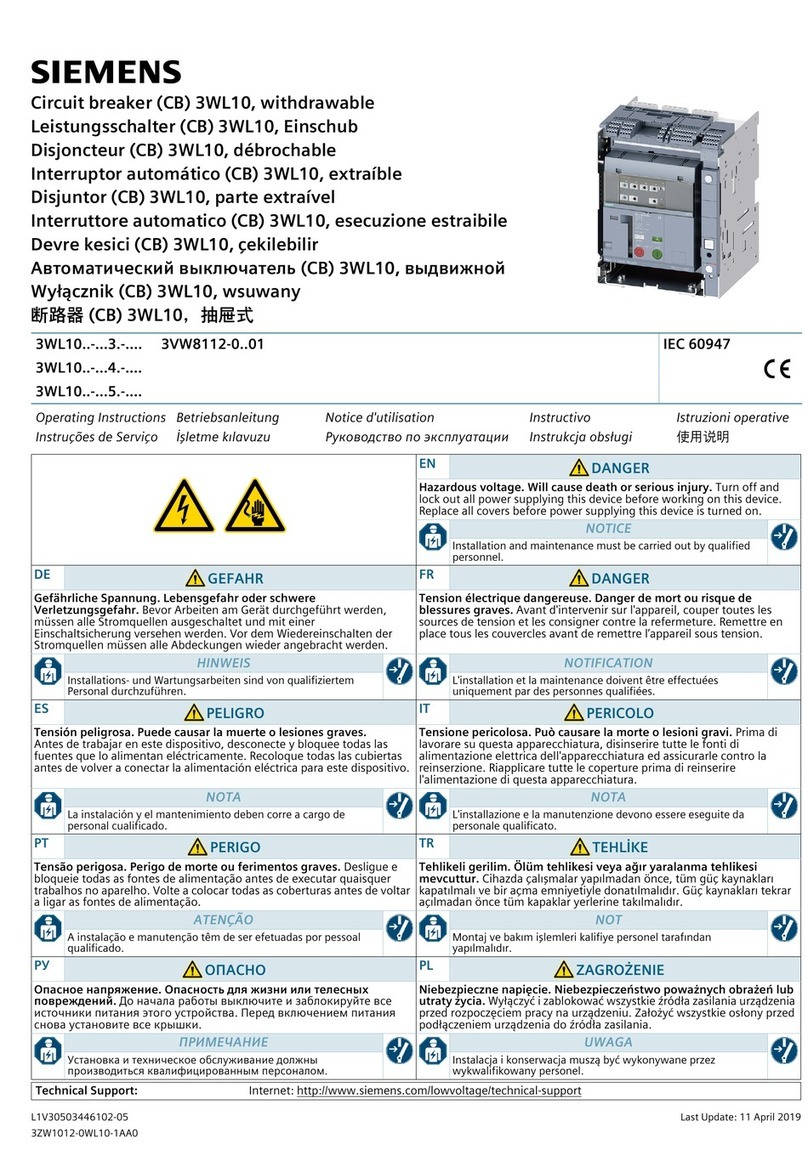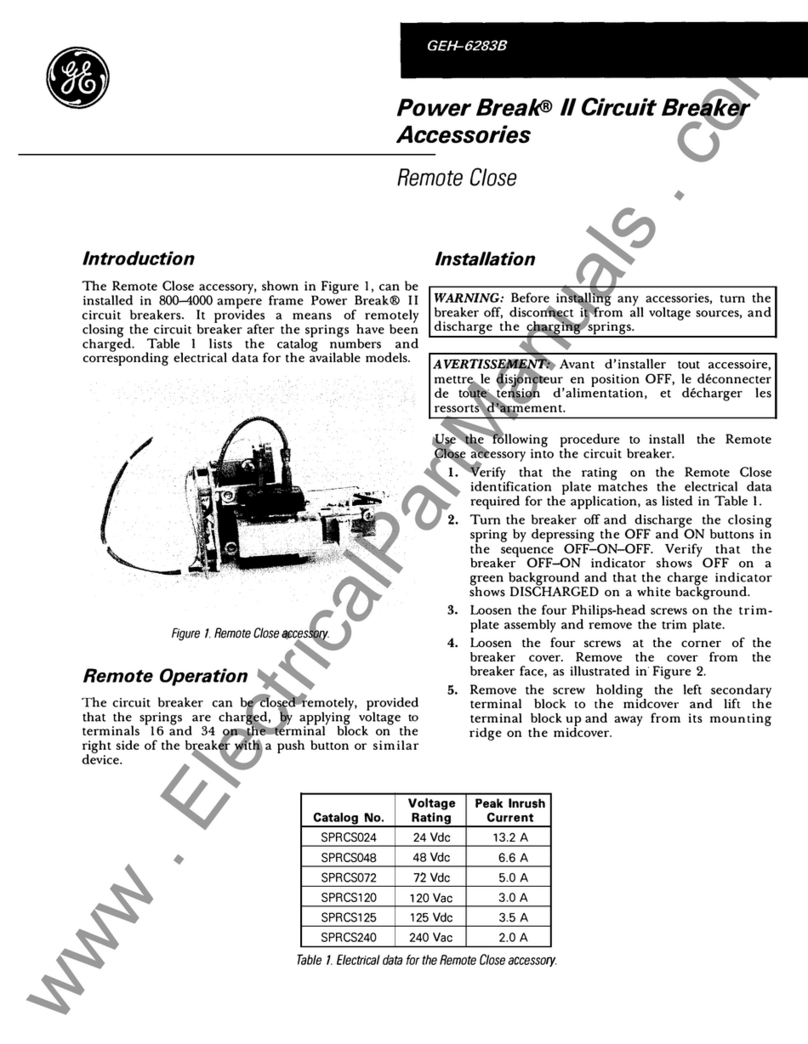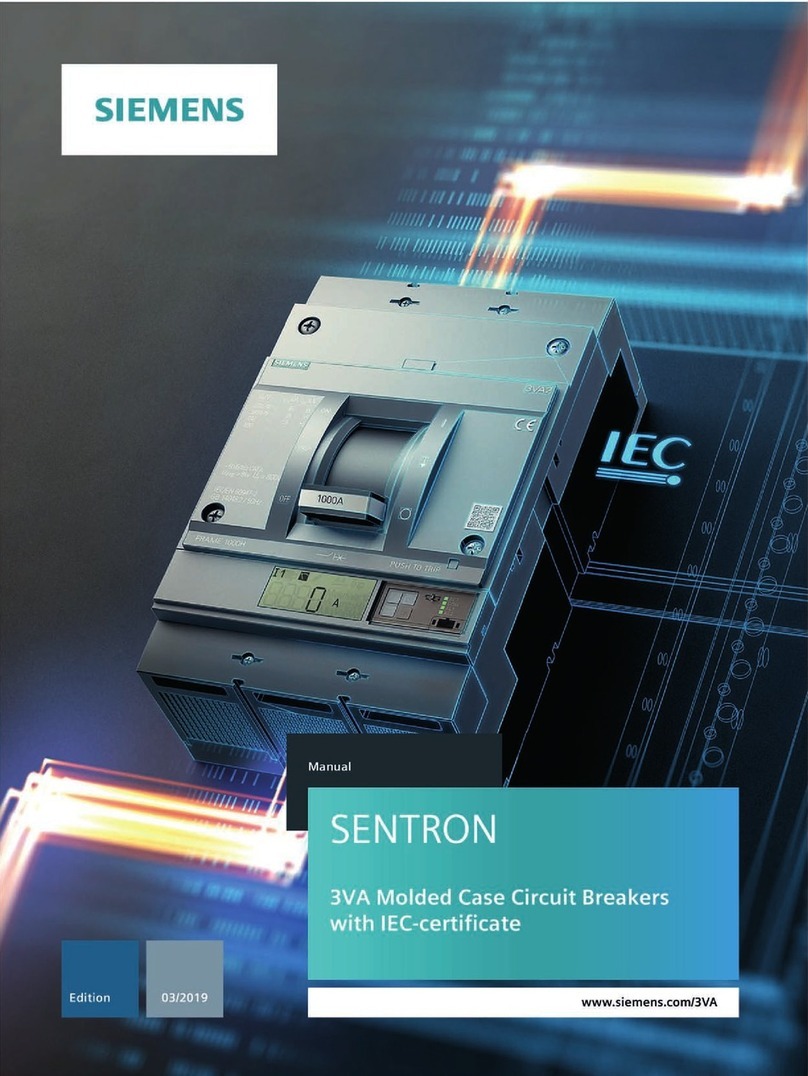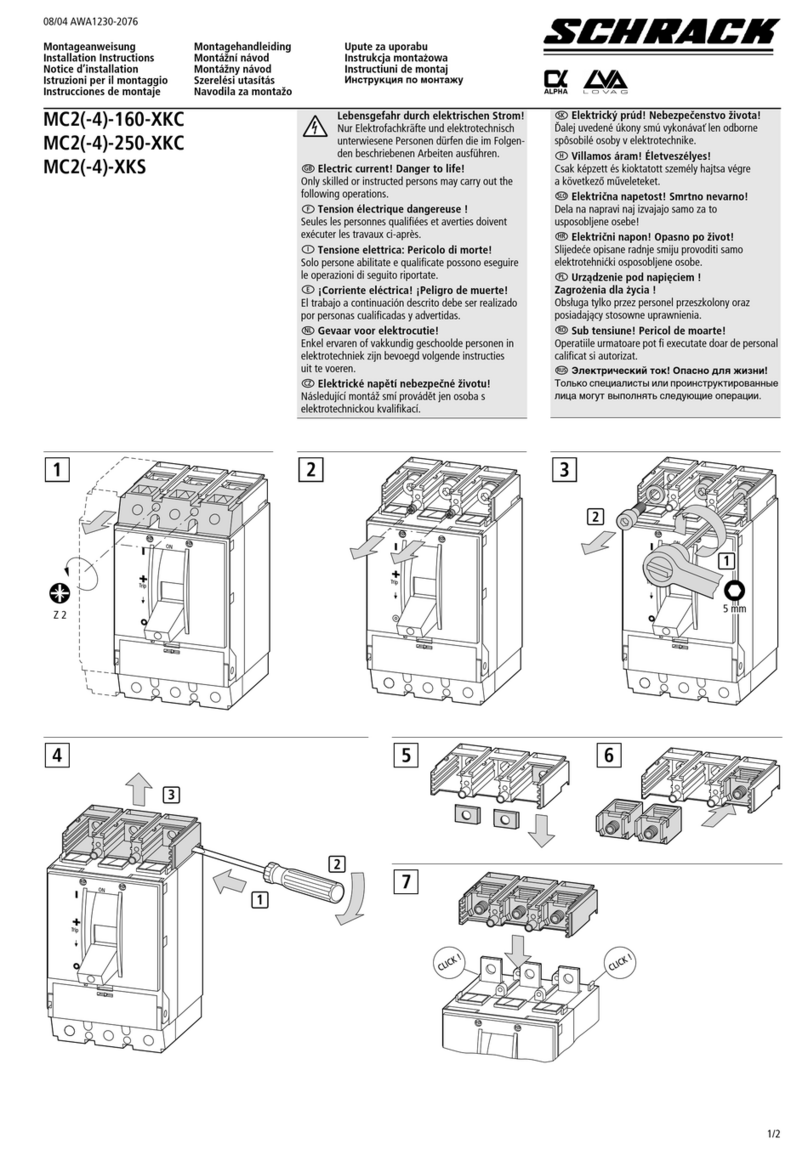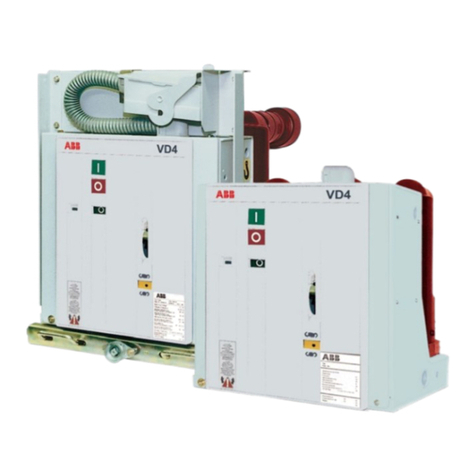Delixi Knight Series User manual

Internal
CDC6H-120~630
AC CONTACTOR
Knight Series
User Manual
Please carefully read this User Manual before the installation and
operation of this product, and keep it properly for future reference

Internal
CDC6H-120~630 AC Contactor
User Manual
Safety Notice
Please carefully read this manual before the installation, operation, run, maintenance, and inspection of
this product, and install and operate this product properly in accordance with the instructions.
Danger
●It is prohibited to operate the contactor with your wed hands;
●Do not touch the energized parts during operation;
●Make sure that the product is de-energized during maintenance and service.
Caution
●The installation, service and maintenance of this product must be carried out by professionally
qualified personnel.
●Please confirm whether the product voltage, current, frequency, and use category meet the
requirements;
●Please turn on the control circuit and carry out the no-load operation test, and then connect to the load
after no abnormality is found.
●Please tighten the wiring terminal and remove remove deposited dust regularly;
●Prevent foreign matters from falling into the product;
●To purchase accessories, users are required to select the matched accessories provided by the
company;
●If found damage or abnormal sound when unpacking the product, please reject it and contact the
supplier;
●When the product is scrapped, please dispose the product waste properly. Thanks for your
cooperation.
About CDC6H-120~630 product
●Introduction to Panel
Fig. 1: Product schematic diagram

Internal
Legends:
1 - Main circuit inlet end 1/L1, 3/L2, 5/L3
2 –Product model
3 - Main circuit outlet end 2/T1, 4/T2, 6/T3
4 - Normally open auxiliary wiring terminal
5 - Normally closed auxiliary wiring terminal
6 - Coil inlet end A1, outlet end A2
7 - Rated operating current, voltage, and power
8 - Insulation voltage Ui: 1000V
9 - Standard: GB/T14048.4
IEC 60947-4-1
10 - Certification mark
11- Resistive current of free air
The specific parameters are listed in Table 1
Model
CDC6H
-120
CDC6H
-160
CDC6H
-185
CDC6H
-225
CDC6H
-265
CDC6H
-330
CDC6H
-400
CDC6H
-500
CDC6H
-630
Rated operating
current Ie(A)
380V/
400V
120
160
185
225
265
330
400
500
630
660V/
690V
86
107
107
118
170
225
303
353
400
Resistive current of free
air Ith(A)
200
275
315
380
450
630
700
Rated insulation voltage
Ui (V)
1000
Rated impulse withstand
voltage (kV)
8
Controllable
three-phase
motor power
(AC-3) KW
380V/
400V
55
75
90
110
132
160
220
250
355
660V/
690V
80
100
110
110
165
220
300
350
450
Electrical life
10,000 times
400V
AC-3
120
80
60
AC-4
Seee electrical life curve
Rated operating
frequency
Times/h
AC-3
1200
600
AC-4
120
60
Flashover distance (mm)
10
Shell protection grade
IP00
Mechanical life
10,000 times
600
Coil voltage Us
AC: 110V, 127V, 220V, 380V AC/DC: 48~130V, 100~250V, 250~500V
Coil
power
Pull-in
(VA)
AC
1800
2100
DC
1000
2800
Hold
(VA)
AC
90
100
DC
10
10
Operation
range
Pull-in
voltage
(85%~110%) Us
(85%~110%) Us
Release
voltage
(20%~70%) Us
(20%~70%) Us
Working
time
Closed "C"
(ms)
20~30 (single voltage), 84~120 (wide
voltage)
90~130
Open "O"
(ms)
15~25 (single voltage), 30~50 (wide
voltage)
15~70
Precaution
In the star-delta starting application, please note that the "closed" and "open" time of the
contactor is matched with the working characteristics of the motor to avoid star-delta
switching action at the peak of the inrush current. Meanwhile, it is recommended to
select the moulded case circuit breaker with motor characteristics protection.

Internal
Electrical life x 106
Breaking current Ic (A)
Fig. 2: Life curve
Normal Operation, Installation, and Transport Conditions
●Normal operation and installation conditions
(1) Ambient air temperature: the ultimate working temperature is ranged -35℃~ +70℃, the normal working
temperature is -5℃~ +55℃, and the mean value within 24 hours does not exceed +35℃. When the working
environment temperature is higher than 55℃, it must be considered that the allowable ultimate temperature rise of
the product may be reduced; by decreasing the rated operating current, the number of the contactors installed in
the standard assembly can be reduced, otherwise the product may be damaged, its service life is shortened, and the
working reliability is reduced, and even the product operating range may be affect; when below than -5℃, it
should be considered that the grease used for insulation and lubrication will freeze at too low ambient
temperature, resulting in product failure. Table 2 lists the correction factors for different rated operating currents
when the operating temperature exceeds +55℃and the rated operating voltage remains unchanged.
Table 2
Ambient temperature(℃)
55℃
60℃
65℃
70
Correction factor
1
0.91
0.92
0.67
(2) The altitude of the installation site does not exceed 2000 m; Normal parameters are available if 2000 m and
below, degrading is required if above 2000 m. Table 3 lists the correction factor for rated impulse withstand
voltage and rated operating current under the condition that the rated voltage remains unchanged when the altitude
is > 2000 m. Table 3
Altitude (m)
2000
3000
4000
Rated impulse withstand voltage coefficient
1
0.9
0.7
Rated operating current coefficient
1
0.87
0.82

Internal
(3) When the maximum temperature is +70℃, the relative humidity of the air does not exceed 50%; higher
relative humidity can be allowed at lower temperatures, such as 90% at +20℃, and protective measures should be
taken for condensation occasionally occurred due to temperature changes;
(4) The installation position should be vertical, and the inclination angle in all directions should not exceed ±5°;
(5) Install in a place where there is no impact vibration and rain and snow intrusion;
(6) Pollution level: Level 3;
(7) Installation category: Class III;
(8) Rated impulse withstand voltage Uimp: 8000V;
(9) Rated frequency: 50/60Hz;
(10) Protection grade: the shell protection grade of the main circuit of the contactor is IP00, and the shell
protection grade of the control circuit and auxiliary circuit is IP20;
(11) Suitable for 8h working system, intermittent cycle work system, uninterrupted working system and short-time
working system.
●Normal storage and transportation conditions
(1) Temperature: -35℃~+70℃, up to +70℃in a short time (24h);
(2) Relative humidity: ≤95%;
(3) The product should be handled gently during transportation, do not upside it down, and avoid strong collision;
(4) The product shall not be attacked by rain and snow during transportation and storage.
Install the product
●All contactors are installed with screws; check that the rated voltage and frequency of the coil are consistent
with those of the control power supply before installation, and it is forbidden to use any damaged or poorly
assembled contactor.
●The product installation requirements see Fig. 3.
Fig. 3 Installation requirements

Internal
●The outline and installation dimensions of the contact are shown in Fig. 4 and Table 4
Fig. 4 Outline and installation dimensions of CDC6H-120~630 product
Table 4 Outline and installation dimensions of CDC6H-120~630 AC contactor Unit: mm
Model
Amax
A1max
Bmax
B1max
Cmax
C1max
C2max
CDC6H-120/160/185/225
168.5
182.5
120
40.5
161
193
217.5
CDC6H-265/330/400
210
200
154
52.5
208
240
264.5
CDC6H-500/630
215
217.5
169
61
231.5
263.5
288
Notes: B1max - Contactor phase spacing C1max - Contactor + FD6
C2max - Contactor + FT6 C3 –Height of fixed screw of contactor
C4 –Height of main circuit wiring of contactor
Model
C3max
C4max
a
b
c
d
CDC6H-120/160/185/225
13.5
109
103±0.5
135±1
153±1
6.5
CDC6H-265/330/400
17
142
128±0.5
173±1
188±1
9
CDC6H-500/630
18
158
130±0.5
180±1
190±1
10
●The outline and installation dimensions of the reversible AC contactor are shown in Fig. 5 and Table 5
Fig. 5 Outline and installation dimensions of CDC6H-120N~630N

Internal
Table 5 Outline and installation dimensions of the CDC6H-120~~630 reversible AC contactor Unit: mm
Model
Fmax
e
f
H
CDC6H-120/160/185/225
241.5
129.5
18
224
CDC6H-265/330/400
309.5
168
27
283
CDC6H-500/630
339.5
189.5
40
300
●Accessory installation
Dust cover
Fig. 6: Accessory installation diagram
(1) Auxiliary contact
CDC6H-120~630 contactor body is equipped with two sets of one pair of normally open and one pair of normally
closed auxiliary contacts as standard configuration, its model is FC4-11, and its main parameters are listed in
Table 6; Table 6 Main parameters of auxiliary contacts
Use
category
Rated
impulse
withstand
voltage
Uimp
Rated
insulation
voltage Ui
Resistive
curren tof
free air Ith
Control capacity
Rated operating current Ie
ON
OFF
220V
380/400V
AC-15
6000V
690V
10A
3600VA
3600VA
3.13A
1.89A
DC-13
33W
0.31A
-

Internal
The contactors can be equipped with independent auxiliary contact modules, and its model, specifications and
normally open and normally closed combination are shown in Table 7. The installation of F4 is consistent with the
installation method of the air delay head, and the installation and disassembly of FC4-11 are shown in Fig. 7 and
Fig. 8. The wiring diagram of FC4-11 is illustrated in Fig. 9.
Fig. 7 FC4-11 installation method Fig. 8 FC4-11 disassembly method
Table 7 Auxiliary contact set
Model & Spec.
FC4-11
Number of normally open (NO) contacts
1
Number of normally closed (NC) contacts
1
Fig. 9 CDC6H-120~630 and FC4-11 wiring diagram
(2) Air delay head
The contactor can be equipped with a FT6 air delay head to form a delay contactor, and its delay range is listed in
Table 8. Table 8 Air delay head
Model & Spec.
Delay range
Number of delay contacts
Delay type
FT6-20
0.1~3s
1NO+1NC
Power-on delay
FT6-22
0.1~30s
FT6-24
10~180s
Note: The air delay head is adjusted to the minimum value before shipment.

Internal
Table 8 Air delay head
Model & Spec.
Delay range
Number of delay contacts
Delay type
FT6-30
0.1~3s
1NO+1NC
Power-off delay
FT6-32
0.1~30s
FT6-34
10~180s
Note: The air delay head is adjusted to the minimum value before shipment.
The installation and disassembly of the air delay head is shown in Figs. 10 and Fig. 11.
When installation: ○
1 Align the chute with the contactor slide rail, ○
2 Push it down until the buckle is
automatically closed;
When disassembly: ○
1 Lift the buckle upwards, ○
2 Push it upwards along the chute to remove.
Fig. 10 Installation of air delay head Fig. 11: Disassembly of air delay head
(3) The installation method of FR4 mechanical interlock is shown in Fig. 12:
○
1 Install FR4
○
2 Install another contactor as shown in figure
○
3 and ○
4 Fix the two contactors with fastening screws, nuts and connecting plates, as shown in the Figure.
Fig. 12 Installation method of mechanical interlock FR4

Internal
(4) The installation and disassembly method of the coil is shown in Fig. 13 and Fig. 14:
Fig. 13 Disassembly method of coil Fig. 14 Installation method of coil
(5) Electromagnetic starter
The contactor can be combined with JR2H series thermal overload relay to form an electromagnetic starter.
Debugging and Operation
●Check whether the technical parameters of the product meet the operation requirements;
●Turn on the control circuit, carry out the no-load operation test, and then connect the load after no any
abnormality is found;
●Prevent foreign objects from falling into the product;
●It is recommended to select SCPD according to type 1 coordinated protection, and the model of its fuse is
listed in Table 8.
●The wiring capacity and tightening torque are listed in Table 8.
Table 8 Model and wiring of matched fuse
Model
CDC6H
-120
CDC6H
-160
CDC6H
-185
CDC6H
-225
CDC6H
-265
CDC6H
-330
CDC6H
-400
CDC6H
-500
CDC6H
-630
Specifications and wiring of fuse of main circuit SCPD
Model & Spec. of fuse of main
circuit
NGTC2
-160A
NGTC2
-200A
NGTC2
-250A
NGTC2
-315A
NGTC2
-400A
NGTC2
-400A
NGTC2
-500A
NGTC2
-630A
NGTC2
-800A
Copper wire
Qty.
1~2
1~2
1~2
Section area
(mm2)
95
150
185
240
185/240
Copper
busbar
Qty.
1~2
1~2
1~2
Section area
LxW (mm)
25x3~30x5
30x5~40x6
30x5~40x6
Tightening
torque
N.m
12
14
14
Specification and wiring of fuse of auxiliary and control circuit SCPD
Model & Spec. of fuse of
aux. circuit
RT16-10A
Hard or soft
copper wire
Qty.
1~2.5
Section area
(mm2)
1~2.5
Tightening
torque
N.m
0.8

Internal
Maintenance and Service
●Please tighten the wiring terminal of the contactor and remove the deposited dust regularly, otherwise there
will be a risk of fire and short circuit;
●Small metal particles sprayed around the contact of contactor or on the arc hood should be removed, and the
contactor shall stop operation when the contact surface is burnt out to expose the base material.
Troubleshooting and Solution
Common troubleshooting and solutions are listed in Table 9.
Table 9 Common Troubleshooting and Solution
Fault
Cause
Solution
The iron core failed
to pull in or the
pull-in force is
insufficient (that is,
the contact has been
closed but the iron
core is incompletely
pulled in)
1. The power supply voltage is too low or
fluctuates too largely;
2. The power supply capacity of the
operating circuit is insufficient or there is
broken wiring, wiring errors, and poor
contact of the control contact;
3. The technical parameters of the coil is
inconsistent with the working conditions;
4. The product itself is damaged (such as
coil broken or burns, mechanical movable
part blocked)
1. Increase the power supply voltage;
2. Increase the power capacity, replace the
line, and repair the control contact;
3. Replace the contactor;
4. Eliminate the blockage failure, and repair
the damaged part.
No release or
release slowly
1. Contact fusion welding;
2. The mechanical movable part is
blocked;
3. There is oil or dust attached onto the
pole surface of iron core.
1. Eliminate fusion welding faults, repair or
replace contactors;
2. Eliminate the blockage failure;
3. Clean the pole surface of iron core.
The coil is
overheated or burnt
out
1. The power supply voltage is too high
or too low;
2. The technical parameters (such as rated
voltage, frequency, power-on duration
rate and applicable working system) of
the coil are inconsistent with the actual
conditions:
3. The moving part is blocked;
4. The pole surface of the iron core is
uneven or attached with dust.
1. Adjust the power supply voltage;
2. Replace the contactor;
3. Eliminate mechanical blockage failure;
4. Clean the pole surface.
Electromagnet (AC)
has large noise
1. The power supply voltage is too low;
2. The magnetic system is skewed or
mechanically blocked, making that the
iron core cannot be pulled in flatly;
3. The pole surface of iron core is rusted
or the foreign matters invades into the
pole surface of iron core;
4. The short circuit ring is broken or the
pole surface of iron core is worn
excessively to cause uneven surface.
1. Increase the voltage of the operating circuit;
2. Adjust the magnetic system or eliminate
mechanical blockage failure ;
3. Clean the pole surface;
4. Replace the contactor.
Contact fusion
welding
1. The operating frequency is too high or
the product is overloaded;
2. Short circuit on the load side;
3. Insufficient pull-in force.
1. Replace it by an appropriate contactor;
2. Eliminate short circuit fault;
3. See insufficient iron core pull-in force part.

Internal
Company’s Commitment
Under the premise that users follow the use and storage conditions and the product are well sealed, within 24
months from the production date, our company will provide repair and replacement service free of charge for any
damage or abnormal operation due to poor manufacture quality. A paid repair will be provided if the warranty
period expires. For any damage due to one of the following situations, a paid repair will be given even if within
the warranty period:
(1) Improper operation, maintenance, or storage;
(2) Modified and inappropriate repair without permission;
(3) Damage due to falling off or during installation after purchase;
(4) Force majeure such as earthquakes, fires, lightning strikes, abnormal voltages, and secondary disasters.
If you have any questions, please contact our dealer or our company’s customer service department.
Customer Service Hotline: 400-826-8008
Delixi Industrial Park, Liushi Town, Yueqing City, Zhejiang Province P.C.: 325604
Tel: (86-577) 6177 8888
Fax: (86-577) 6177 8000
Customer Service Hotline: 400-826-8008
www.delixi-electric.com
This manual suits for next models
9
Other Delixi Circuit Breaker manuals
Popular Circuit Breaker manuals by other brands
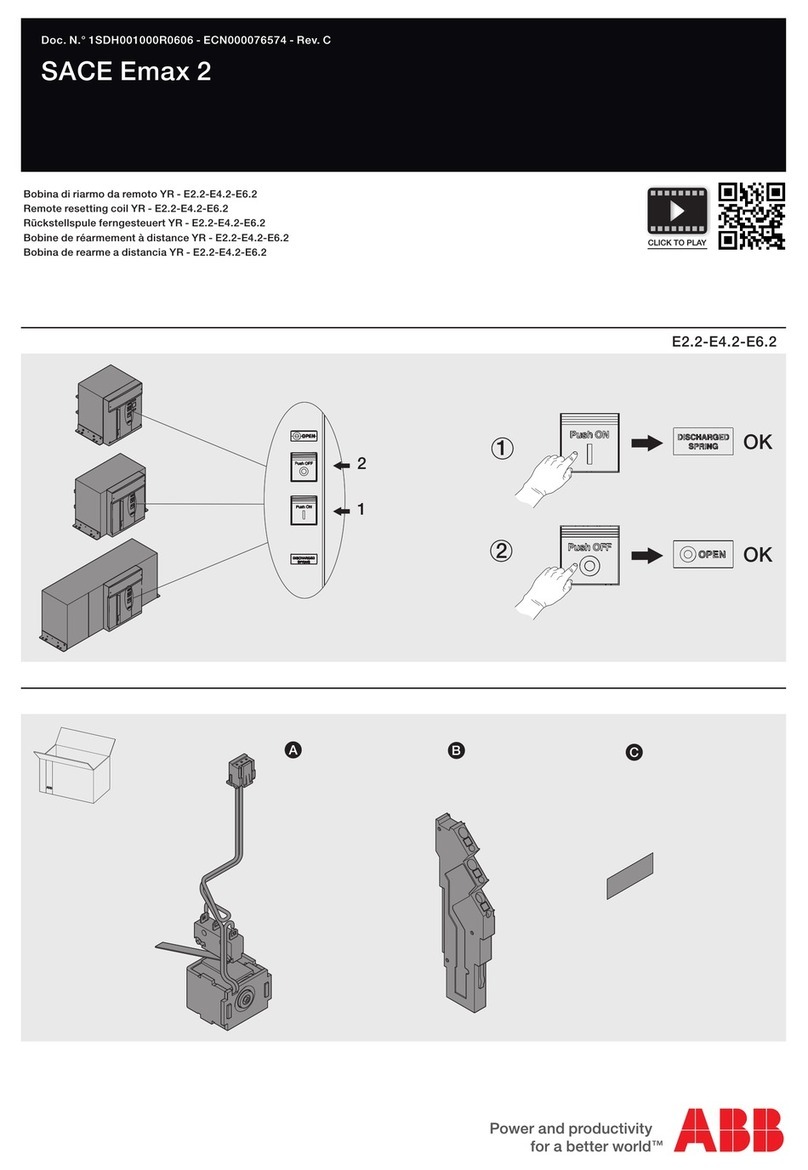
ABB
ABB SACE Emax 2 manual

Block
Block ECONOMY SMART PC-FU/DC24 manual
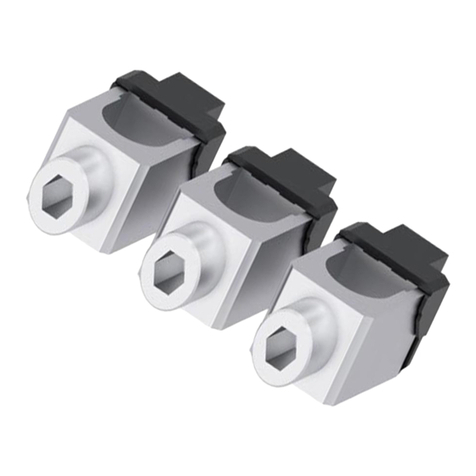
Siemens
Siemens 3VA9 7 0JA1 Series operating instructions
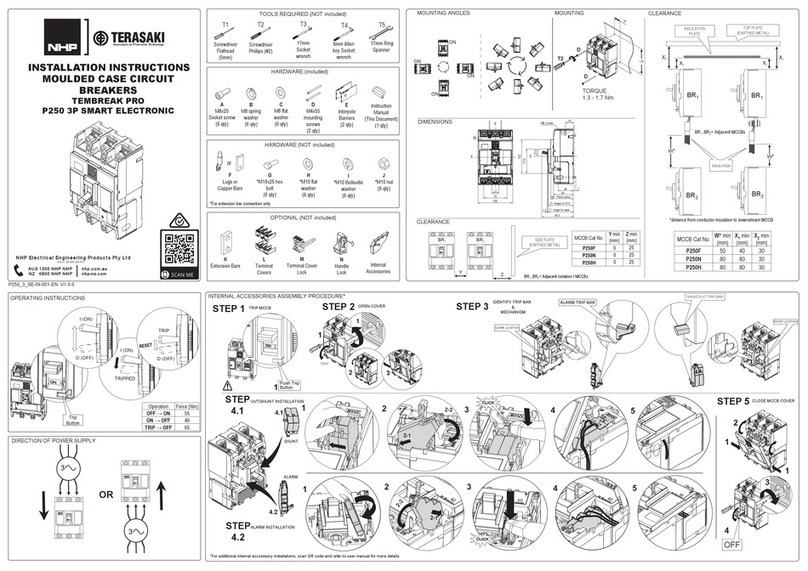
NHP
NHP TERASAKI TEMBREAK PRO P250 3P installation instructions
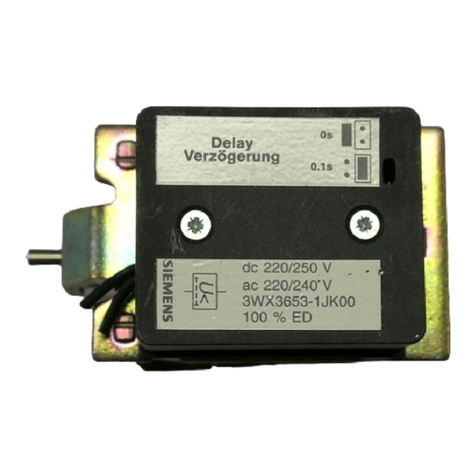
Siemens
Siemens 3WX3653-1J 00 Series operating instructions
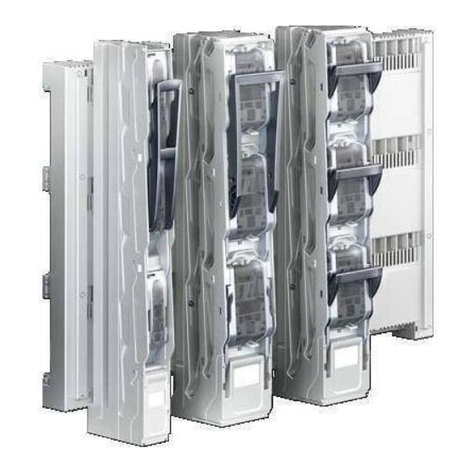
Rittal
Rittal SV 9677.100 Assembly and operating instructions
